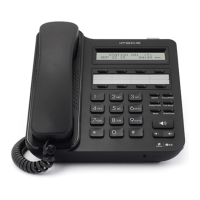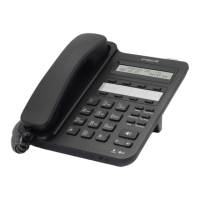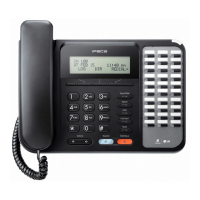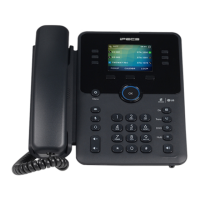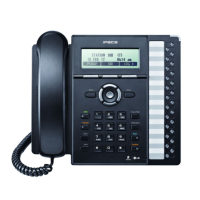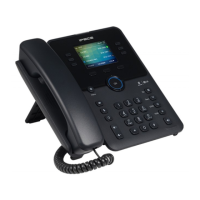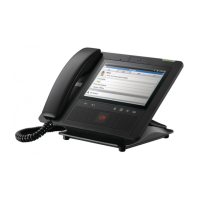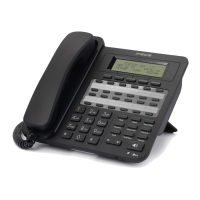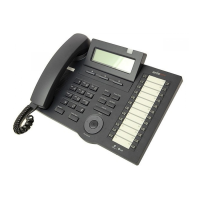Do you have a question about the LG-Ericsson iPECS LDP-9200 Series and is the answer not in the manual?
Provides essential warnings and cautions for safe phone installation, usage, and maintenance to prevent damage or injury.
Details the compliance of the equipment with EU directives for radio and telecommunications.
Outlines FCC/IC compliance for digital devices and potential interference.
Introduces the advanced telecom system, feature access methods, and general operational considerations.
Describes the primary functions of key buttons like Ring/Message Indicator, LCD Display, Handset, Speaker, and Dial Pad.
Details the functions of essential fixed buttons for call management and system programming.
Explains the usage of Directory, Do-Not-Disturb, and Call Back buttons for communication.
Covers the functionality of Mute, Hold/Save, and Ear Mic. Headset buttons for call control.
Lists and describes different DSS console models available for the LDP-9200 series phones.
Provides step-by-step instructions for installing the DSS console onto the LDP-9200 series phones.
Details phone connection ports and information regarding compatible headsets.
Explains the procedure for mounting the LDP-9200 series phones on a wall.
Provides character entry charts for LDP-9208D/9224D phones to register station names.
Details the character entry chart for LDP-9224DF/9240D phones for station name registration.
Presents the character entry chart for LDP-9200 series phones for various inputs.
Explains how to assign features to flex buttons and how to make them empty.
Lists commonly used feature codes for programming flex buttons.
Covers navigation of the phone's display menu and the specific attendant menu options.
Details how to activate and control the speakerphone functions for calls.
Explains methods for answering incoming calls while idle.
Describes how to handle incoming calls when already on another call (Call Waiting).
Covers the usage of Answering Machine Emulation for screening calls.
Details differential ring signals and answering calls during night mode.
Explains how to pick up calls ringing at other stations or groups.
Covers activating Do-Not-Disturb to block incoming calls.
Details methods for forwarding calls to other stations or voice mail.
Explains how to forward calls to external destinations.
Describes how to forward callers to a text message.
Covers placing internal calls, including using Camp-On for busy stations.
Explains how to leave a message wait indication for called users.
Details how to place external calls via CO/IP lines and handle busy lines.
Covers using account codes for billing and disabling phone dialing.
Explains how to temporarily override dialing restrictions for a single call.
Describes accessing and using phone directories for different models.
Covers Last Number Redial (LNR) and Saved Number Dial functions.
Explains how to use System and Station Speed Dial numbers.
Details the ACNR feature for automatically retrying busy numbers.
Explains sending active calls to different destinations, screened or unscreened.
Covers placing calls on hold and switching between calls (Broker Call).
Details joining multiple parties in a conference and setting up conference rooms.
Explains how to place calls on hold in a special location (Park Orbit) for retrieval.
Describes responding to station message waiting indicators and reviewing messages.
Covers accessing and managing voice mail messages and remote call forward.
Explains sending, receiving, and deleting short text messages.
Covers Direct Inward System Access (DISA) and using mobile phone extensions.
Explains how to view a log of received, dialed, and lost calls.
Details system settings for background music and music on hold.
Covers making internal, external, and meet-me page announcements.
Explains how to log in/out and use Push-To-Talk page groups.
Describes setting and responding to the station's alarm clock.
Covers alarm/door bell monitoring, power fail transfer, and system voice memos.
Explains how to access PBX or Centrex features from the phone.
Details accessing ISDN network features like keypad facility, supplementary services, and caller ID restriction.
Covers entering station program data and assigning features to flex buttons.
Lists fixed function codes for user program mode, used for assigning flex buttons and settings.
Provides descriptions of the 9 basic numbering plans available.
Details default numbering plan codes for eMG80/eMG800 and UCP systems.
| Brand | LG-Ericsson |
|---|---|
| Model | iPECS LDP-9200 Series |
| Category | Telephone |
| Language | English |
